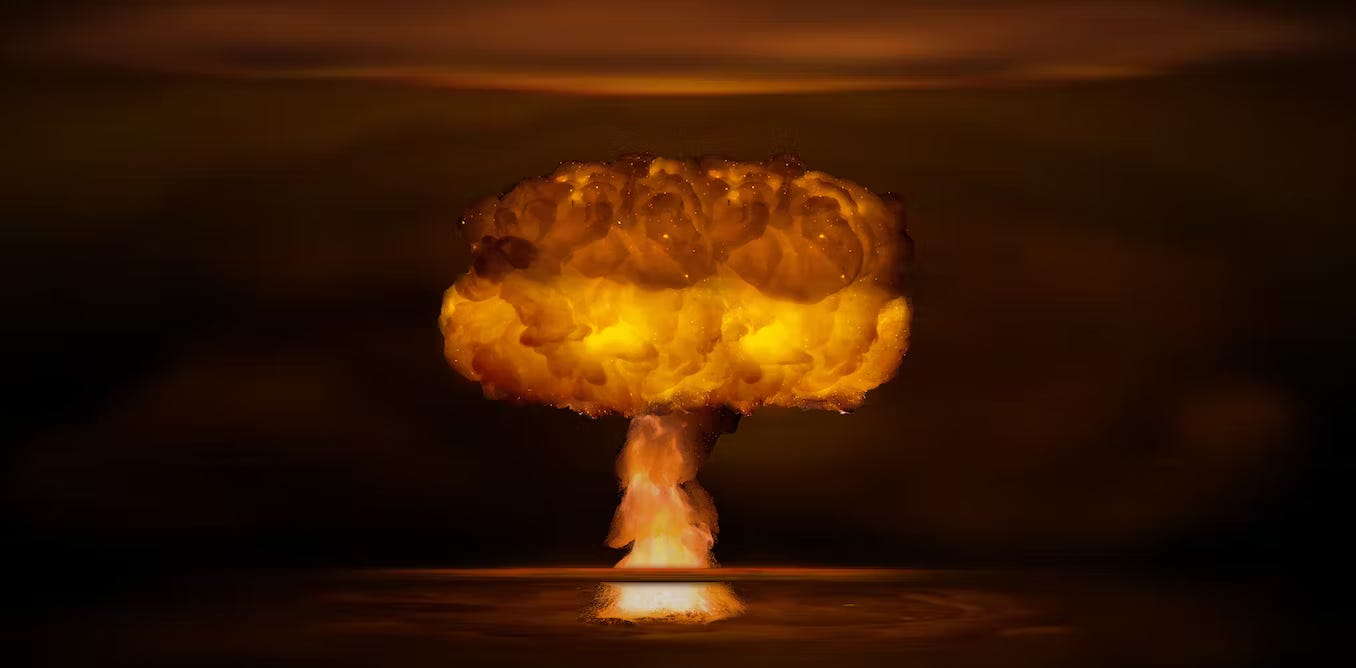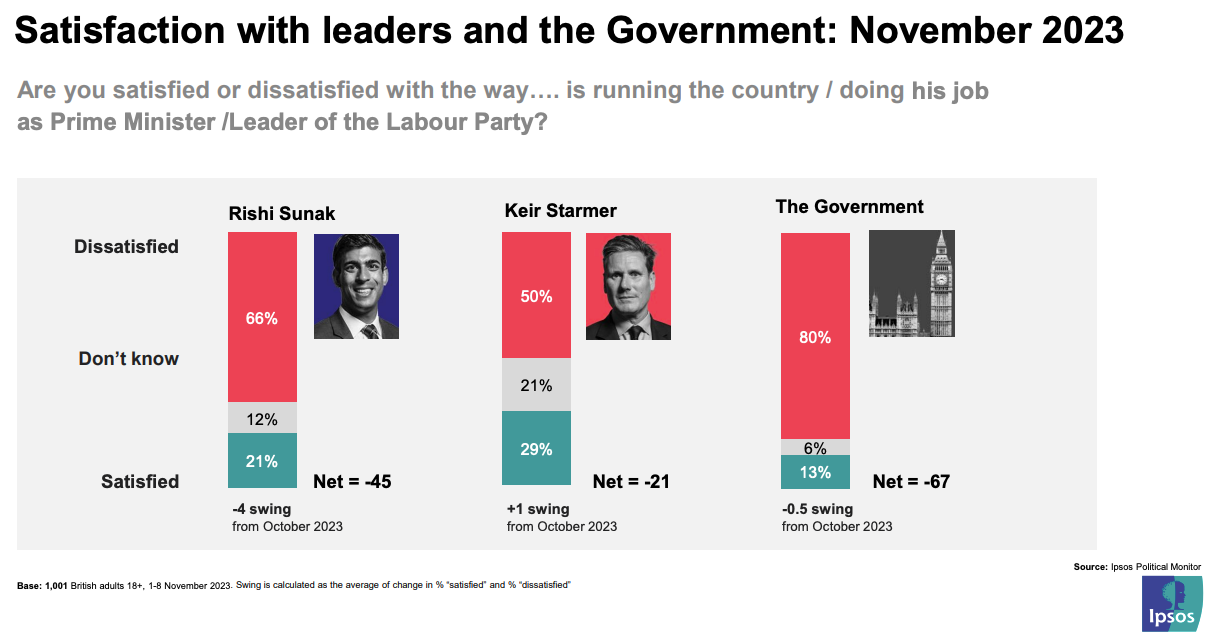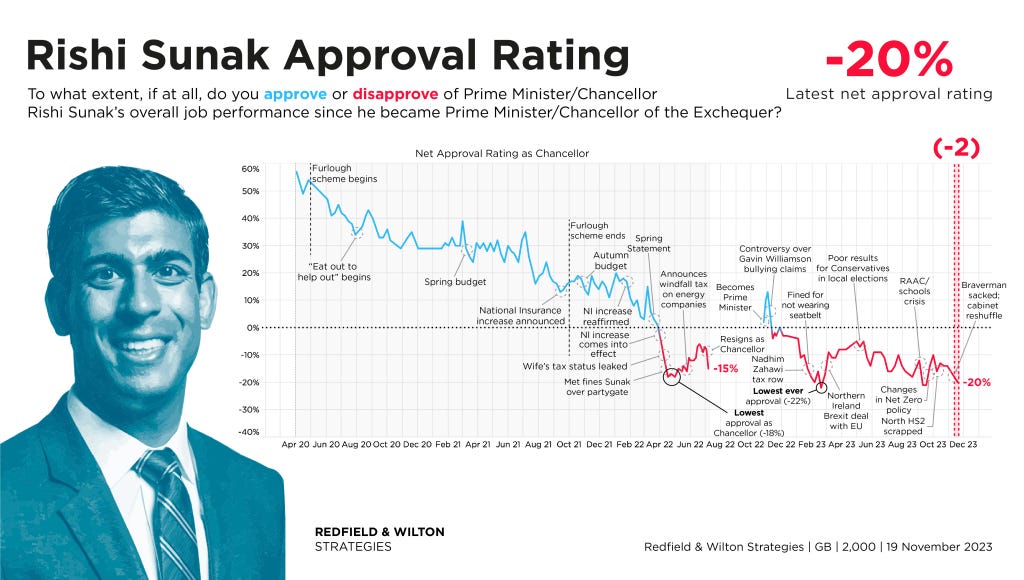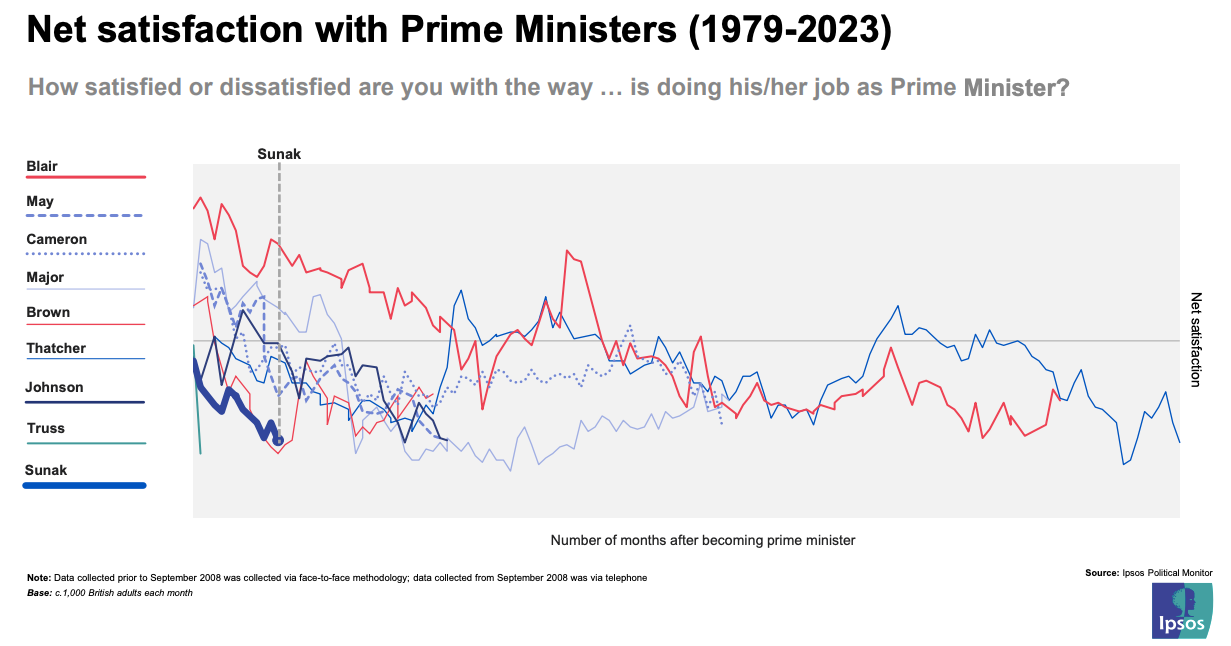The Nightmare Scenario
One possible route to the total destruction of the Tory party
Matt Goodwin’s Substack goes to more than 57,100 subscribers from 167 countries around the world and thousands of paying supporters who support our work. Like our stuff? Then help us expand by becoming a paid supporter and access everything —the full archive, Live with Matt every Friday, exclusive posts, polling, leave comments, join the debate, get discounts, notice about events, and the knowledge you’re supporting independent writers who are pushing back against the grain. Join us on YouTube, Instagram, TikTok, Twitter/X and Facebook.
I just gave a talk to 400 financial analysts at Schroders, in the City of London. They wanted an overview of Britain’s forthcoming general election —the key trends, the public mood, what I think will happen. And then somebody asked me about the future of the Conservative Party. So here’s what I told them and why the Tories might soon face what I call a “nightmare scenario”.
The Conservative Party is imploding. This week, in the aftermath of Rishi Sunak’s reshuffle, which saw the sacking of national conservative Suella Braverman and the return of liberal conservative David Cameron, the Tories are averaging just 24% of the vote while Labour holds a commanding 20-point lead.
What does this mean? Well, here are two statistics to keep in mind over the next year. First, the Tories need a lead of at least 3 points in the polls if they are to pull off a surprise and win a surprise, 1992-style victory. Second, Labour will need a lead of at least 12.5 points to win their first majority since 2005. So, currently, Labour are safely in majority territory and have actually been over-performing their position in the polls at real world by-elections on the ground, so the picture is pretty clear.
Were the current poll numbers replicated at an election next year the Tories would slump to about 140 seats while Labour would be handed an enormous majority of more than 200 —bigger even than its majority in 1997. Britain’s political geography would once again be overturned. All of the Red Wall seats would flip back to being just that —Red— while a long list of frontline Tories would see their political careers come to an abrupt end. Lee Anderson. Tobias Ellwood. Iain Duncan Smith. Brandon Lewis. Andrea Leadsome. Miriam Cates. Jacob Rees-Mogg. Grant Shapps. Steve Baker. All gone. It would be an existential event for the Tories. And one that would take years to recover from. The Tories would then immediately be thrust into a protracted philosophical and ideological civil war over the soul of conservatism.
And things could easily get much worse before the election. Look at how the polls are changing. This week, as I noted on Twitter, support for the renegade Reform party jumped to 10% —their highest level so far. Currently, one in five 2019 Tory voters have jumped ship to Reform, whose honorary president is none other than Brexiteer-in-Chief Nigel Farage (who is currently eating crocodile testicles in the Australian jungle and yet to discover that David Cameron, his old foe, is now back in government). With concern over immigration soaring, with disillusionment with Westminster palpable, with a major cost-of-living crisis, Reform should arguably be polling much better and may soon be comfortably in the 10-15% range.
Were I advising Reform I’d be saying just talk about immigration, immigration, immigration, and the cost-of-living crisis, the cost-of-living crisis, the cost-of-living crisis. Dump Net Zero. Dump taxation. Dump anything that is not central to that core message. Small parties only prosper when they have a very tight, focused message, not when they are trying to be a big party that is all things to all people.
Look at the data and you’ll soon see why the Tories are collapsing. They’ve actually been declining for months. There has simply been no visible or sustained recovery since Rishi Sunak was appointed prime minister and, as we were told at the time, the “adults were back in charge”. Both the Tory party’s and Rishi Sunak’s ratings have continued to slide. The government’s ‘net satisfaction’ rating today is minus 67. To put that figure in context, Prince Andrew’s approval rating is about the same. Sure, Keir Starmer is not particularly popular among the British public either but Starmer’s still nowhere near as unpopular as Rishi Sunak and the Tory government. Remember, opposition leaders and parties don’t win elections —governments lose them. All Keir Starmer has to do is be seen as less shit than the other guy.
The Tory brand is now utterly toxic in the minds of many voters —having hoovered up all the negative energy that flowed from Brexit, Boris, partygate, Liz Truss, the mini-budget, and more. The party has successfully alienated both culturally conservative Red Wallers, by failing to lower immigration, strengthen the borders, and level-up the left behind regions, and socially liberal Blue Wallers through Brexit, Boris, Liz Truss, and general incompetence. It simply never made a choice about what it wants to be and now looks totally lost. It has gone from giving the world a masterclass in how to bring about a political realignment to giving the world a masterclass in how to then completely lose touch with it. The Tories’ traditional secret weapon —the power of reinvention— is nowhere to be seen. As the recent reshuffle reflects, the Tories appear more interested in returning to the liberal patrician Toryism of the David Cameron era —which set the stage for the rise of UKIP, Brexit, and the turbulence of the 2010s— than genuinely moving forward into a bold new conservatism with a bold new set of ideas.
Rishi Sunak’s approval rating, meanwhile, is similarly dire. It stands at minus 18. It is certainly true that, once-upon-a-time, during Covid-19, Rishi Sunak was the most popular politician in the country. You tend to be popular when you are giving away hundreds of billions of pounds in furlough. But today he is simply nowhere near as popular as both he and his social media team like to think. Nor has his leadership style improved. There is simply no charisma or connection with the British people. He remains utterly wooden, technocratic, managerial, dry, and too nerdy. A relative of mine speaks for many when they describe Rishi Sunak as the “Inbetweener Prime Minister” —somebody who looks and sounds like a nerdy, tech bro, sixth former who does not seem to grasp how other people think and live their lives.
Even now, a year on from his appointment as prime minister, voters still do not know where Rishi Sunak wants to take the country. He looks aloof, in a world of his own, focusing on detail while failing to put together a clear and compelling story about who he is and how he wants to change Britain. This was best reflected in his recent conference speech at Manchester. While voters were crying out for things to help them with the most severe cost-of-living crisis for half a century, with the sharpest decline in living standards since the Second World War, Sunak decided to lecture them about the need to ban smoking, reform A-levels, and stop a train-line. He just looked and sounded completely at odds with the rest of the country —a technocratic dwelling on the detail of what many people see as utterly fringe concerns compared to the very big issues of the day. It seemed to reflect a prime minister and maybe a team around him that has either decided to focus on a few pet projects while they have power and before they lose the next general election or are just out-of-step with the rest of the country. Nor has Sunak clearly and visibly disassociated himself from his two main and very unpopular predecessors, Liz Truss and Boris Johnson. His weakness within the parliamentary party, his lack of mandate, means he cannot do this as ruthlessly as it would otherwise need to be done. And while Sunak is still adored by more than a few people in Westminster and the commentariat, the fact is, as Ipsos-MORI point out, he is still one of the most unpopular prime ministers in recent history.
Meanwhile, on all of the big, salient, pressing issues facing Britain —the issues that will determine what happens next year—Rishi Sunak and the Tories are nowhere to be seen. Ask the British people whether they think the Tory government is doing a good or bad job and the answer is routinely the same.
Handling Brexit? Bad job. Managing the economy? Bad job. Dealing with the cost-of-living crisis? Bad job. Fixing the NHS? Bad job. Managing immigration? Bad job. Stopping the boats? Bad job. Dealing with crime? Bad job. Levelling-up the left behind regions? Bad job. The only thing voters think the Tories got right is Ukraine but even then most voters don’t really care about Ukraine. It’s just not a pressing concern for them and is now being taken over by Israel-Gaza. In fact, the Tories are so weak that, today, Labour is seen as the best option when it comes to managing crime, Brexit, and immigration. That’s right. Such is the scale of the Tory disaster that LABOUR is now the party of Brexit and immigration. LOL.
And look at public services. Just look at the chart below before I set out the nightmare scenario. It is remarkable and utterly devastating for the Tories.
Keep reading with a 7-day free trial
Subscribe to Matt Goodwin to keep reading this post and get 7 days of free access to the full post archives.





